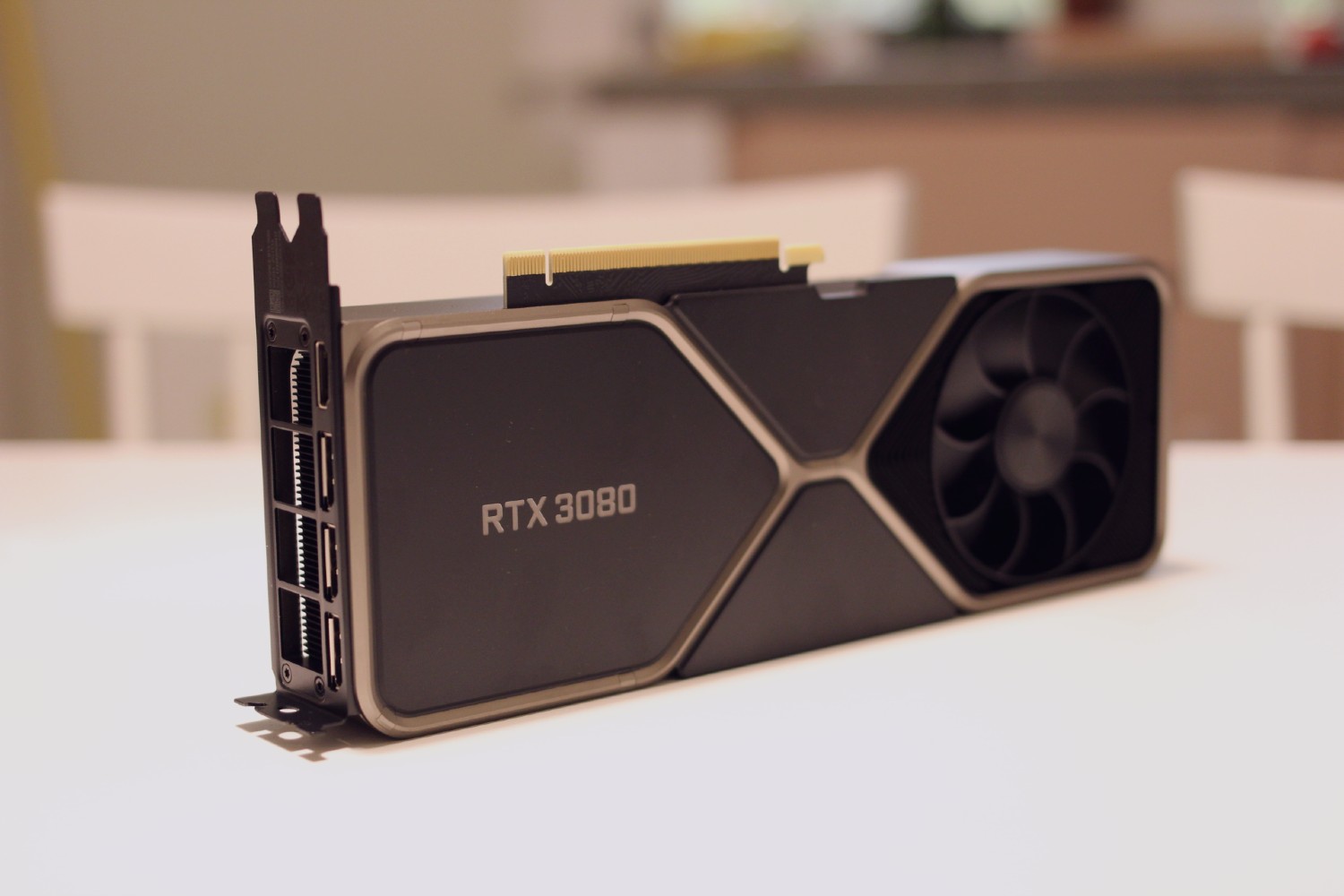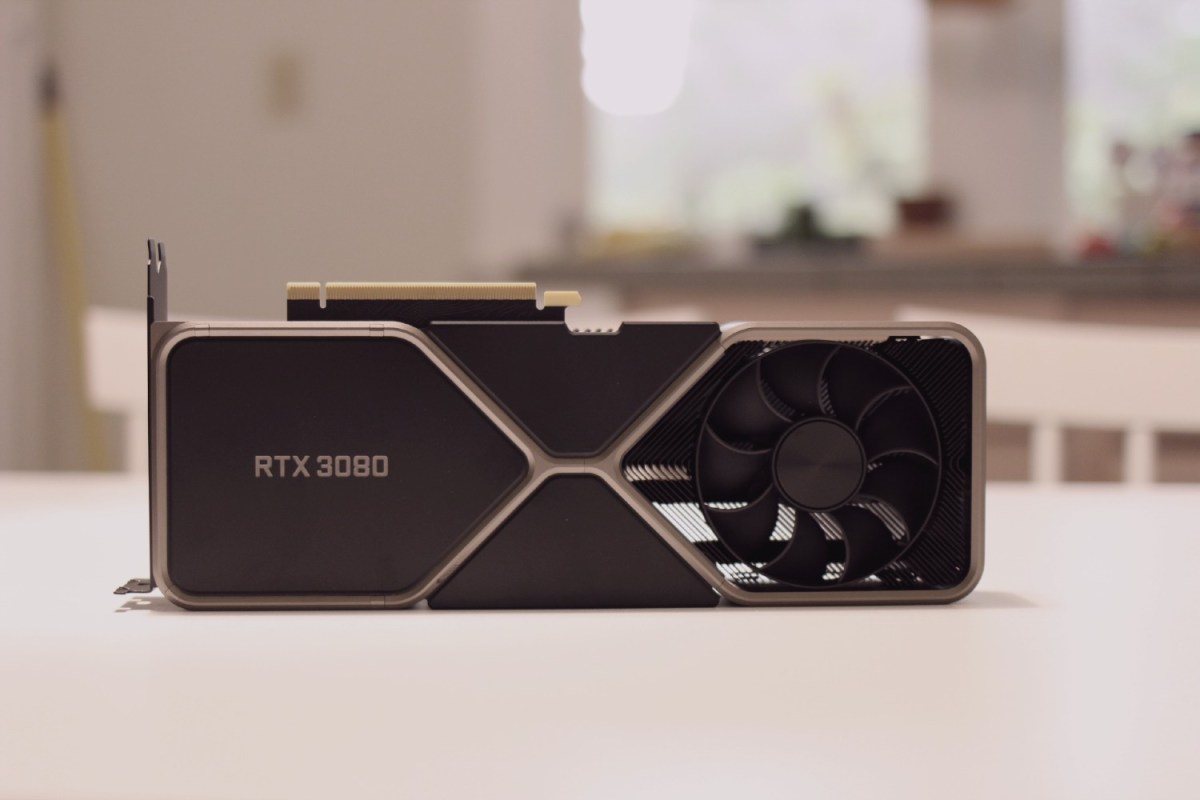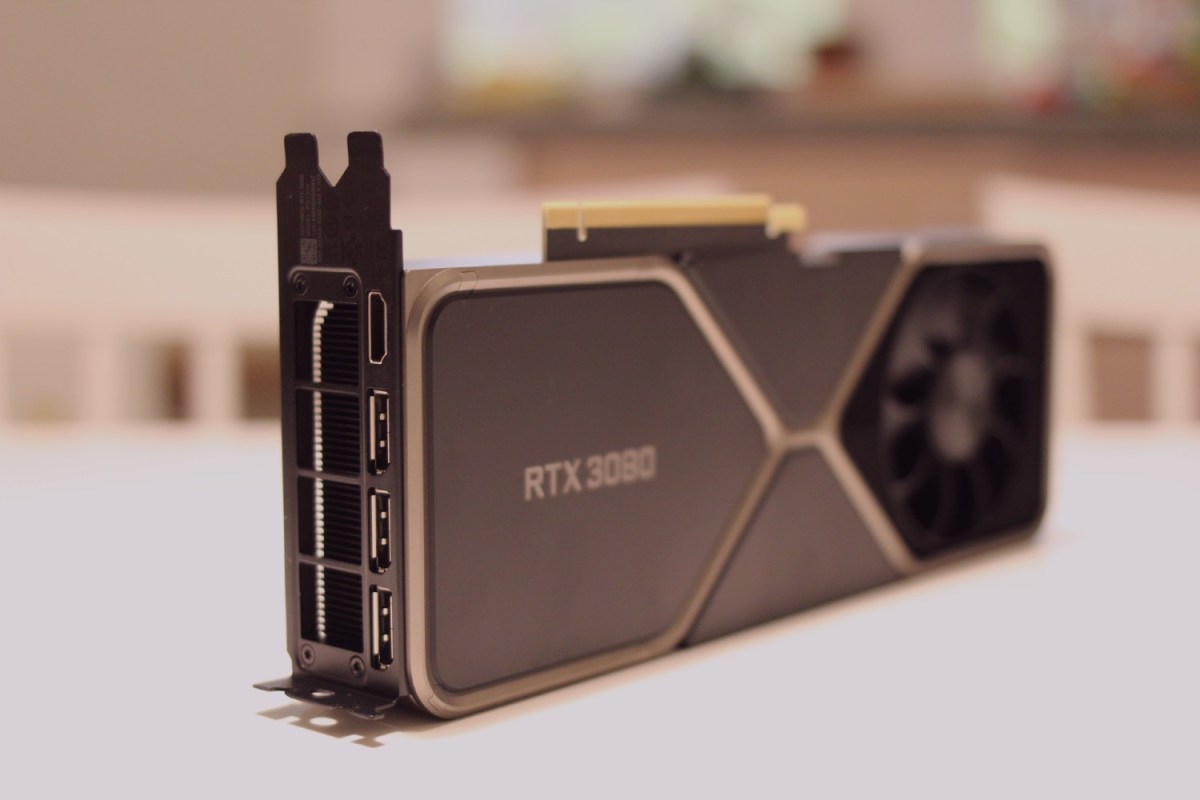
- Fast and fluid 4K gaming
- Attractive new design
- HDMI 2.1 support
- Improved ray tracing and DLSS performance
- Needs awkward adapter
- Requires more power
The gaming world’s attention is focused squarely on the upcoming console launches. I get it. Gamers are finally getting PC-level gaming in the living room. Between the price and the upgraded internals, these new consoles are a big deal.
But Nvidia hasn’t let the consoles, which are powered by AMD hardware, steal the spotlight.
The Nvidia RTX 3080, which is available starting today, along with the rest of the RTX 3000-series, represents the future of PC gaming. Boasting the most significant generational leap in Nvidia’s history, the RTX 3080 is out to prove that true high-end gaming will always belong on the PC. Is this the next leap forward in PC gaming? Or have consoles finally caught up?
Design

The RTX 3080 is one classy-looking video card.
The previous generation of Nvidia GPUs, from the RTX 2060 up to the RTX 2080 Ti, wanted you to know how premium an experience you were getting. The shroud and backplate were aluminum, and the “Nvidia GeForce” logo glowed green when powered up. The Super models even added a highly reflective glass-like texture to the surface.
The RTX 3080 takes a more subtle approach. It uses a matte, dark gray material. It even features white back-lighting instead of green. None of this is showy, but it’s in line with the more simplistic direction of modern gaming gear. It won’t stick out sitting next to a stark white NZXT H510i case or a Razer Blade 15. Straight lines and muted colors are fashionable, and the RTX 3080 reflects that.

For something with a bit more edge, third-party cards from Asus or MSI will likely work just fine. For me, Nvidia’s reference model looks great.
Apart from the look, the RTX 3080 also features a redesigned cooling system. A fan flanks each side of the shroud, using a unique “push-pull” system of heat management. One side sucks air in, and another exhausts it out the back. Nvidia says this results in better airflow, but the RTX 3080 runs slightly hotter than the RTX 2080 Ti. In the same run of 3DMark Time Spy, the RTX 3080 maxed at 76 degrees Celsius, four degrees hotter than the RTX 2080 Ti. Both still stayed clear of the 80 degree mark throughout all my tests.
The RTX 3080 is nearly identical in size to the RTX 2080 Ti and 2080 Super. Unlike the massive RTX 3090, the 3080 features just a standard two-slot design. It slid comfortably into a 28-liter case that previously housed an RTX 2070 Super. It’s still a large
Power and ports

Though it’ll likely fit in your case, the RTX 3080 is power-hungry. It demands 320 watts of dedicated power, and to account for this, Nvidia recommends at least a 750-watt power supply to support your whole system. That alone may mean buying a new PSU for your system. Previously, 650 watts was the standard to support cards like the RTX 2080 Super or 2080 Ti.
And yes, the rumors are true — the RTX 3080 features a new 12-pin power connector that requires an adapter to work with your old cables. Nvidia includes the adapter in the box, though still leaves an awkward dangling dongle in your case.
For ports, the Nvidia RTX 3080 includes three DisplayPort 1.4a, which support up to 144Hz at
The USB-C port is gone, which was a feature of the RTX 20-series to support NVLink, a way for running dual GPUs over SLI. Connecting multiple cards to boost frame rates is now an exclusive feature of the RTX 3090. Multi-GPU support was already dwindling, and the removal of NVLink on the RTX 3080 is the nail in the coffin.
Architecture
The Nvidia RTX 3080, along with the 3070 and 3090, use Nvidia’s new Ampere microarchitecture. It’s based on Samsung’s 8nm node, shrinking the die from the 12nm node used in the Turing architecture. This means more transistors, and theoretically, higher efficiency.
Ampere features a massive 50% jump in CUDA cores, now up to 8,704. Nvidia’s GPUs are made up of streaming multiprocessors (SM), the individual units of processing power that contain its CUDA cores.
There’s an important caveat here. The Ampere microarchitecture has changed how each CUDA core works in a way that actually makes each individual a bit less performant. So, a 50% jump in CUDA cores doesn’t directly translate to a 50% increase in frame rates, though it’s what gets you the 29.7 teraflops of theoretical performance. Still, this is a major boost in core count, and — spoiler alert — it’s going to have an impact when we get to our performance tests.
| Cuda cores | Memory | Memory interface | Boost clock | Graphics card power | |
| RTX 3090 | 10,496 | 24GB GDDR6X | 384-bit | 1.70GHz | 350w |
| RTX 3080 | 8,704 | 10GB GDDR6X | 320-bit | 1.71GHz | 320w |
| RTX 3070 | 5,888 | 8GB GDDR6 | 256-bit | 1.73GHz | 220w |
| RTX 2080 Ti | 4,352 | 11GB GDDR6 | 352-bit | 1.54GHz | 250w |
| RTX 2080 Super | 3,072 | 8GB GDDR6 | 256-bit | 1.82GHz | 250w |
| RTX 2070 Super | 2,560 | 8GB DRR6 | 256-bit | 1.77GHz | 215w |
Ampere also brings more
Lastly, the RTX 3080 features 10GB of 320-bit GDDR6X memory. That’s two more GBs of faster video memory, almost up to the 11GB that’s offered in the RTX 2080 Ti. That’s an important spec, beneficial in games that use large textures and large amounts of on-screen data. It also shows how Nvidia has shifted its entire line of GPUs up a notch.
Performance

Let’s cut to the chase, shall we?
The performance of the RTX 3080 is impressive in almost all cases. Until the RTX 3090 launches in a few weeks, it’ll easily be the most powerful
I assumed it would beat its predecessor, the RTX 2080 Super. But the real fun was discovering just how much faster it really is. Being able to compare it to the far more expensive RTX 2080 Ti was the icing on the cake.
My test system included a CML B460 MATX motherboard, 16GB of DDR4 2933MHz
Until the RTX 3090 launches, the RTX 3080 is easily the most powerful
I started with 3DMark Time Spy, the DirectX12 benchmark that provides a level playing field for testing graphics of all kinds. Here, the RTX 3080 proves surpassed the RTX 2080 Ti by 15%. Not a huge lead, but let’s not forget the $500 price difference between these two cards. That’s a larger price gap than between other cards in the stack. The performance gap between the RTX 2080 Ti and RTX 2080 Super is also wider.
Meanwhile, the RTX 3080 beats the 2080 Super by 28%, all without a price hike.
That lead continued as I tried a number of games, both in 1440p and
Let’s start with the most challenging title first. Assassin’s Creed Odyssey is a game that no system I’ve tested can play at native
Next, I booted up Battlefield V. Historically, it’s one of the few games where Nvidia GPUs have lagged behind AMD. But not this time. The RTX 3080 enjoys its biggest leap in the games I tested, now averaging up to 97 fps in

As expected, the RTX 3080’s lead is highest in
As for Fortnite, the gains weren’t quite as high, largely because the RTX 2080 Ti already played it well. It was the only game where in lower resolutions (such as 1080p), the RTX 2080 Ti actually outdid the RTX 3080. In
Lastly, let’s look at some lighter fare. Civilization VI is a game that is ideal in
Across all these games, you won’t see as big of a gain playing in 1080p or at lower settings. In Battlefield V at 1080p Ultra settings, for example, the RTX 3080 was only a few fps ahead of the RTX 2080 Ti. That was also true in Fortnite and Civilization VI, where you begin to lose a bit of the value of the RTX 3080. If you don’t plan on upgrading your monitor for either higher resolution or refresh rate, the RTX 3080 is not worth your time. You’re better off saving some money and waiting for the RTX 3070 or inevitable RTX 3060.
Content creation
Outside of gaming, a powerful GPU like the RTX 3080 can significantly speed up content-creation tasks like video rendering or 3D modeling. Though a lot of the heavy lifting is carried by the CPU in these tasks, a powerful GPU can make a difference in render times.
I started with Adobe Premiere Pro, where I loaded up a project with a two-minute
Ray tracing and DLSS

The RTX 2080 Ti launched with almost zero titles support
Still, RTX is much stronger today than it was. It makes for a good time to launch some new high-powered GPUs that take both
I tested out one of the first games to integrate RTX features: Battlefield V. Happily, I discovered that the
In the mission Tirailleur, the RTX 2080 Ti allows for some brilliant reflections in the puddles of water near the start of the level, which can slow down the frame rate to an average of 33 fps. Once DLSS was turned on, that was bumped up to 45 fps. This was in
The true realization of real-time
On the RTX 3080, those numbers look a bit more promising. This new card handles the same scene with the same settings at 55 fps and jumps up to 69 fps with DLSS. There’s room to grow, but at least in Battlefield V,
I also tested out the new
But even with the RTX 3080, these RTX features are still a performance bottleneck. It averaged 53 fps in 1440p in Ultra with all the RTX features maxed. But in
Of course, the game also offers a number of DLSS settings (Quality, Balanced, or Performance) that boost the frame rate back up through upsampling. The “Performance” setting adds some noticeable blur to distant textures, while the “Quality” setting only gets you back up to 27 fps. In the end, the combination of DLSS and
Our take
The RTX 20-series was criticized for paying more attention to
The RTX 3080 will never be Nvidia’s most popular card with its $699 price point, but as the industry leader and “flagship” model, it represents the best that PC gaming can offer.
Are there any alternatives?
The closest alternatives are also made by Nvidia: The RTX 3090 and RTX 3070. The 3090 is the most expensive (and most powerful)
AMD’s upcoming RX 6000 graphics are rumored to include a high-end GPU that could finally challenge Nvidia’s top-shelf
How long will it last?
The Nvidia RTX 3080 should last you at least five years. The most common
Should you buy it?
Yes. For top-notch, blisteringly fast PC gaming, the Nvidia RTX 3080 sets a new standard.




